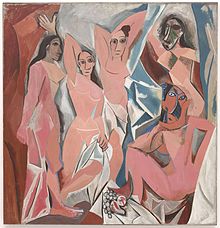
Back Styl (beeldende kunste) Afrikaans أسلوب (فنون مرئية) Arabic Estil artístic Catalan Umělecký sloh Czech Stil (æstetik) Danish Kunststil German Kunstistiil Estonian سبک (هنرهای تجسمی) Persian Ոճ (գեղարվեստական) Armenian Stijl (kunst) Dutch


In the visual arts, style is a "... distinctive manner which permits the grouping of works into related categories"[1] or "... any distinctive, and therefore recognizable, way in which an act is performed or an artifact made or ought to be performed and made".[2] Style refers to the visual appearance of a work of art that relates to other works with similar aesthetic roots, by the same artist, or from the same period, training, location, "school", art movement or archaeological culture: "The notion of style has long been historian's principal mode of classifying works of art".[3]
Style can be divided into the general style of a period, country or cultural group, group of artists or art movement, and the individual style of the artist within that group style. Divisions within both types of styles are often made, such as between "early", "middle" or "late".[4] In some artists, such as Picasso for example, these divisions may be marked and easy to see; in others, they are more subtle. Style is seen as usually dynamic, in most periods always changing by a gradual process, though the speed of this varies greatly, from the very slow development in style typical of prehistoric art or Ancient Egyptian art to the rapid changes in Modern art styles. Style often develops in a series of jumps, with relatively sudden changes followed by periods of slower development.
After dominating academic discussion in art history in the 19th and early 20th centuries, so-called "style art history" has come under increasing attack in recent decades, and many art historians now prefer to avoid stylistic classifications where they can.[5]
- ^ Fernie, Eric. Art History and its Methods: A critical anthology. London: Phaidon, 1995, p. 361. ISBN 978-0-7148-2991-3
- ^ Gombrich, 150
- ^ George Kubler summarizing the view of Meyer Schapiro (with whom he disagrees), quoted by Alpers in Lang, 138
- ^ Elkins, s. 1
- ^ Elkins, s. 2; Kubler in Lang, 163–164; Alpers in Lang, 137–138; 161